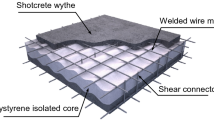Abstract
To resolve the issue regarding inaccurate prediction of the hysteretic behavior by micro-based numerical analysis for partially-restrained (PR) steel frames with solid reinforced concrete (RC) infill walls, an innovative simplified model of composite compression struts is proposed on the basis of experimental observation on the cracking distribution, load transferring mechanism, and failure modes of RC infill walls filled in PR steel frame. The proposed composite compression struts model for the solid RC infill walls is composed of α inclined struts and main diagonal struts. The α inclined struts are used to reflect the part of the lateral force resisted by shear connectors along the frame-wall interface, while the main diagonal struts are introduced to take into account the rest of the lateral force transferred along the diagonal direction due to the complicated interaction between the steel frame and RC infill walls. This study derives appropriate formulas for the effective widths of the α inclined strut and main diagonal strut, respectively. An example of PR steel frame with RC infill walls simulating simulated by the composite inclined compression struts model is illustrated. The maximum lateral strength and the hysteresis curve shape obtained from the proposed composite strut model are in good agreement with those from the test results, and the backbone curve of a PR steel frame with RC infill walls can be predicted precisely when the inter-story drift is within 1%. This simplified model can also predict the structural stiffness and the equivalent viscous damping ratio well when the inter-story drift ratio exceeds 0.5%.
Similar content being viewed by others
References
Alemayehu DH (2011), “Development of New Material Model for Reinforced Concrete under Plane Stress and Its Application in the Modeling of Steel Frames with Reinforced Concrete Infill Walls,” Ph.D. Dissertation, University of Cincinnati.
AISC (2016), Specification for Structural Steel Buildings, Chicago (IL): American Institute of Steel Construction.
GB 50011 English Version (2010), Code for Seismic Design of Buildings, China: China Architecture & Building Press.
Hajjar JF (2002), “Composite Steel and Concrete Structural Systems for Seismic Engineering,” Journal of Constructional Steel Research, 58(5-8): 703–723.
Hognestad E, Hanson NW and Mchenry D (1955), “Concrete Stress Distribution in Ultimate Strength Design,” ACI Structural Journal, 52(4): 455–479.
Hou HT, Chou CC, Zhou J, et al. (2016), “Cyclic Tests of Steel Frames with Composite Lightweight Infill Walls,” Earthquake and Structures, 10(1): 163–178.
Kishi N and Chen WF (1990), “Moment-Rotation Relations of Semi-Rigid Connections with Angles,” Journal of Structural Engineering, 116(7): 1813–1834.
Liao FY, Han LH and Tao Z (2009), “Seismic Behavior of Circle CFST Columns and RC Shear Wall Mixed Structures: Experiments,” Journal of Constructional Steel Research, 65: 1582–1596.
Liao FY, Han LH and Tao Z (2012), “Performance of Reinforce Concrete Shear Walls with Steel Reinforced Concrete Boundary Columns,” Engineering Structures, 44: 186–209.
Mo YL, Zhong JX and Hsu TTC (2008), “Seismic Simulation of RC Wall-Type Structures,” Engineering Structures, 30(11): 3167–3175.
Peng XT and Gu Q (2013), “Seismic Behavior Analysis for Composite Structures of Steel Frame-Reinforced Concrete Infill Wall,” The Structural Design of Tall and Special Buildings, 22: 831–846.
Saari WK, Hajjar JF, Schultz AE and Shield CK (2004), “Behavior of Shear Studs in Steel Frames with Reinforced Concrete Infill Walls,” Journal of Constructional Steel Research, 60(10): 1453–1480.
Speicher MS, DesRoches R and Leon RT (2011), “Experimental Results of a NiTi Shape Memory Alloy (SMA)-Based Recentering Beam-Column Connection,” Engineering Structures, 33: 2448–2457.
Sun GH (2010), “Hysteretic Behavior of Partially-Restrained Steel Frame with RC Infill Wall Structural System,” Ph.D. dissertation, Beijing University of Science and Technology. (in Chinese)
Sun GH, He RQ, Gu Q and Fang YZ, (2011), “Cyclic Behavior of Partially-Restrained Steel Frame with RC Infill Walls,” Journal of Constructional Steel Research, 67(12): 1821–1834.
Tong XD (2001), “Seismic Behavior of Composite Steel Frame-Reinforced Concrete Infill Wall Structural System,” Ph.D. Dissertation, University of Minnesota.
Tong XT, Hajjar JF, Schultz AE and Shield CK (2005), “Cyclic Behavior of Steel Frame Structures with Composite Reinforced Concrete Infill Walls and Partially-Restrained Connections,” Journal of Constructional Steel Research, 61(4): 531–552.
Yan P (2006), “Hysteretic Behavior and Design Criterion of Composite Steel Frame-Reinforced Concrete Infill Wall Structural System with FR Connections,” Ph.D. Dissertation, Xi’an University of Architecture and Technology. (in Chinese)
Acknowledgment
This research was financially supported by National Science Foundation of China (No. 51108292), and the Qing Lan project of Jiangsu Province. The authors wish to express their sincere gratitude to the sponsors.
Author information
Authors and Affiliations
Corresponding author
Additional information
Supported by: National Science Foundation of China under Grant No. 51108292, and Qing Lan Project of Jiangsu Province
Rights and permissions
About this article
Cite this article
Sun, G., Chuang-Sheng, W.Y., Gu, Q. et al. An effective simplified model of composite compression struts for partially-restrained steel frame with reinforced concrete infill walls. Earthq. Eng. Eng. Vib. 17, 403–415 (2018). https://doi.org/10.1007/s11803-018-0449-6
Received:
Accepted:
Published:
Issue Date:
DOI: https://doi.org/10.1007/s11803-018-0449-6




